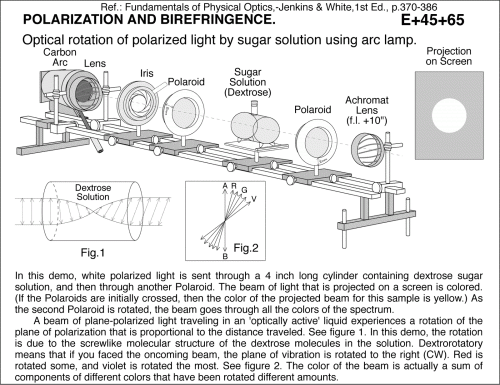Optical rotation of polarized light by sugar solution, using arc lamp.
Primary tabs
In this demo, white polarized light is sent through a 4 inch long cylinder containing dextrose sugar solution, and then through another Polaroid. The beam of light that is projected on a screen is colored. (If the Polaroids are initially crossed, then the color of the projected beam for this sample is yellow.) As the second Polaroid is rotated, the beam goes through all the colors of the spectrum. A beam of plane-polarized light traveling in an 'optically active' liquid experiences a rotation of the plane of polarization that is proportional to the distance traveled. See figure 1. In this demo, the rotation is due to the screwlike molecular structure of the dextrose molecules in the solution. Dextrorotatory means that if you faced the oncoming beam, the plane of vibration is rotated to the right (CW). Red is rotated some, and violet is rotated the most. See figure 2. The color of the beam is actually a sum of components of different colors that have been rotated different amounts. Optical rotation of polarized light by sugar solution using arc lamp. Ref.: Fundamentals of Physical Optics,-Jenkins & White,1st Ed., p.370-386
UCB Index:
E+45+65
PIRA Index:
6H30.41
Demo Picture:
UCB Taxonomy:
PIRA Taxonomy:
Video:
Popularity:
- Log in to post comments

